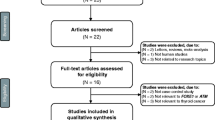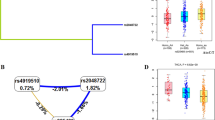Abstract
The aim of this study is to investigate the associations between E-cadherin gene (CDH1) polymorphisms and papillary thyroid carcinoma (PTC) risk predisposition. We undertook a case–control study to analyze three CDH1 polymorphisms (+54T>C, −160C>A, and −347G→GA) in an Han Chinese population, by extraction of genomic DNA from the peripheral blood of 98 patients with PTC and 176 control participants, and performed CDH1 genotyping using DNA sequencing. The obtained results indicated that overall, no statistically significant association was observed in +54T>C. Nevertheless, −347G→GA genotype was at increased risk of PTC (P = 0.001; odds ratio (OR) = 2.12, CI 95%:1.24–3.34). Furthermore, −347GA/GA genotype thyroid cancers were more significantly common in patients with tumor size of ≥20 mm than G or G/GA genotypes PTC and in cases of advanced T stage. However, −160C>A genotype demonstrated a protective effect in PTCs (P = 0.006; OR = 0.59, CI 95%: 0.42–0.87). These findings led us to conclude that polymorphism in −347G→GA was observed to be associated with susceptibility of PTC. However, −160C>A polymorphism indicated to play a protective role in susceptibility to PTC. Nevertheless, further investigation with a larger sample size is needed to support our results.
Similar content being viewed by others
References
Y.E. Nikiforov, Is ionizing radiation responsible for the increasing incidence of thyroid cancer? Cancer 116(7), 1626–1628 (2010). doi:10.1002/cncr.24889
L. Hegedus, Clinical practice. The thyroid nodule. N. Engl. J. Med. 351(17), 1764–1771 (2004). doi:10.1056/NEJMcp031436
R. Paschke, K.W. Schmid, R. Gartner, K. Mann, H. Dralle, C. Reiners, Epidemiology, pathophysiology, guideline-adjusted diagnostics, and treatment of thyroid nodules. Med. Klin. (Munich) 105(2), 80–87 (2010). doi:10.1007/s00063-010-1011-9
D.S. Dean, H. Gharib, Epidemiology of thyroid nodules. Best Pract. Res. Clin. Endocrinol. Metab. 22(6), 901–911 (2008). doi:10.1016/j.beem.2008.09.019
C. Martinez-Rico, F. Pincet, J.P. Thiery, S. Dufour, Integrins stimulate E-cadherin-mediated intercellular adhesion by regulating Src-kinase activation and actomyosin contractility. J. Cell Sci. 123(Pt 5), 712–722 (2010). doi:10.1242/jcs.047878
J. Kucharczak, S. Charrasse, F. Comunale, J. Zappulla, B. Robert, I. Teulon-Navarro, A. Pelegrin, C. Gauthier-Rouviere, R-Cadherin expression inhibits myogenesis and induces myoblast transformation via Rac1 GTPase. Cancer Res. 68(16), 6559–6568 (2008). doi:10.1158/0008-5472.CAN-08-0196
S.C. Suzuki, M. Takeichi, Cadherins in neuronal morphogenesis and function. Dev. Growth Differ. 1(50 Suppl), S119–S130 (2008). doi:10.1111/j.1440-169X.2008.01002.x
H.C. Chen, R.Y. Chu, P.N. Hsu, P.I. Hsu, J.Y. Lu, K.H. Lai, H.H. Tseng, N.H. Chou, M.S. Huang, C.J. Tseng, M. Hsiao, Loss of E-cadherin expression correlates with poor differentiation and invasion into adjacent organs in gastric adenocarcinomas. Cancer Lett. 201(1), 97–106 (2003)
U. Cavallaro, G. Christofori, Cell adhesion and signalling by cadherins and Ig-CAMs in cancer. Nat. Rev. Cancer 4(2), 118–132 (2004)
K.S. Nadella, G.N. Jones, A. Trimboli, C.A. Stratakis, G. Leone, L.S. Kirschner, Targeted deletion of Prkar1a reveals a role for protein kinase A in mesenchymal-to-epithelial transition. Cancer Res. 68(8), 2671–2677 (2008). doi:10.1158/0008-5472.CAN-07-6002
A. Mitselou, E. Ioachim, D. Peschos, K. Charalabopoulos, M. Michael, N.J. Agnantis, T. Vougiouklakis, E-cadherin adhesion molecule and syndecan-1 expression in various thyroid pathologies. Exp Oncol 29(1), 54–60 (2007)
E. Brecelj, S. Frkovic Grazio, M. Auersperg, M. Bracko, Prognostic value of E-cadherin expression in thyroid follicular carcinoma. Eur. J. Surg. Oncol. 31(5), 544–548 (2005). doi:10.1016/j.ejso.2005.02.003
A.S. Rocha, P. Soares, E. Fonseca, J. Cameselle-Teijeiro, M.C. Oliveira, M. Sobrinho-Simoes, E-cadherin loss rather than beta-catenin alterations is a common feature of poorly differentiated thyroid carcinomas. Histopathology 42(6), 580–587 (2003)
G. Serini, L. Trusolino, E. Saggiorato, O. Cremona, M. De Rossi, A. Angeli, F. Orlandi, P.C. Marchisio, Changes in integrin and E-cadherin expression in neoplastic versus normal thyroid tissue. J. Natl. Cancer Inst. 88(7), 442–449 (1996)
P. Soares, G. Berx, F. van Roy, M. Sobrinho-Simoes, E-cadherin gene alterations are rare events in thyroid tumors. Int. J. Cancer 70(1), 32–38 (1997). doi:10.1002/(SICI)1097-0215(19970106)70:1<32:AID-IJC5>3.0.CO;2-7
A.S. Rocha, P. Soares, R. Seruca, V. Maximo, X. Matias-Guiu, J. Cameselle-Teijeiro, M. Sobrinho-Simoes, Abnormalities of the E-cadherin/catenin adhesion complex in classical papillary thyroid carcinoma and in its diffuse sclerosing variant. J. Pathol. 194(3), 358–366 (2001). doi:10.1002/path.905
A. Nakamura, T. Shimazaki, K. Kaneko, M. Shibata, T. Matsumura, M. Nagai, R. Makino, K. Mitamura, Characterization of DNA polymorphisms in the E-cadherin gene (CDH1) promoter region. Mutat. Res. 502(1–2), 19–24 (2002)
Y. Shin, I.J. Kim, H.C. Kang, J.H. Park, H.R. Park, H.W. Park, M.A. Park, J.S. Lee, K.A. Yoon, J.L. Ku, J.G. Park, The E-cadherin −347G>GA promoter polymorphism and its effect on transcriptional regulation. Carcinogenesis 25(6), 895–899 (2004). doi:10.1093/carcin/bgh073
L.C. Li, R.M. Chui, M. Sasaki, K. Nakajima, G. Perinchery, H.C. Au, D. Nojima, P. Carroll, R. Dahiya, A single nucleotide polymorphism in the E-cadherin gene promoter alters transcriptional activities. Cancer Res. 60(4), 873–876 (2000)
H. Yamada, K. Shinmura, S. Ikeda, H. Tao, T. Otani, T. Hanaoka, T. Tsuneyoshi, S. Tsugane, H. Sugimura, Association between CDH1 haplotypes and gastric cancer risk in a Japanese population. Scand. J. Gastroenterol. 42(12), 1479–1485 (2007). doi:10.1080/00365520701478436
L. Gao, A. Nieters, H. Brenner, Meta-analysis: tumour invasion-related genetic polymorphisms and gastric cancer susceptibility. Aliment. Pharmacol. Ther. 28(5), 565–573 (2008). doi:10.1111/j.1365-2036.2008.03760.x
S.B. Edge, American Joint Committee on Cancer: AJCC Cancer Staging Manual, 7th edn. (Springer, New York, 2010)
F. van Roy, G. Berx, The cell–cell adhesion molecule E-cadherin. Cell. Mol. Life Sci. 65(23), 3756–3788 (2008). doi:10.1007/s00018-008-8281-1
S. Baranwal, S.K. Alahari, Molecular mechanisms controlling E-cadherin expression in breast cancer. Biochem. Biophys. Res. Commun. 384(1), 6–11 (2009). doi:10.1016/j.bbrc.2009.04.051
A. Jeanes, C.J. Gottardi, A.S. Yap, Cadherins and cancer: how does cadherin dysfunction promote tumor progression? Oncogene 27(55), 6920–6929 (2008). doi:10.1038/onc.2008.343
H.J. Martens, V. Geenen, Focal adhesion kinases: interest in immunoendocrinology, developmental biology, and cancer. Endocrine 13(3), 233–242 (2000). doi:10.1385/ENDO:13:3:233
F. Cattaneo, T. Venesio, S. Molatore, A. Russo, R. Fiocca, M. Frattini, A.I. Scovassi, L. Ottini, L. Bertario, G.N. Ranzani, Functional analysis and case-control study of -160C/A polymorphism in the E-cadherin gene promoter: association with cancer risk. Anticancer Res. 26(6B), 4627–4632 (2006)
X.F. Zhang, Y.M. Wang, H. Ge, Y.Y. Cao, Z.F. Chen, D.G. Wen, W. Guo, N. Wang, Y. Li, J.H. Zhang, Association of CDH1 single nucleotide polymorphisms with susceptibility to esophageal squamous cell carcinomas and gastric cardia carcinomas. Dis Esophagus 21(1), 21–29 (2008). doi:10.1111/j.1442-2050.2007.00724.x
M.S. Al-Moundhri, M. Al-Khanbashi, M. Al-Kindi, M. Al-Nabhani, I.A. Burney, A. Al-Farsi, B. Al-Bahrani, Association of E-cadherin (CDH1) gene polymorphisms and gastric cancer risk. World J. Gastroenterol. 16(27), 3432–3436 (2010)
B. Zhang, K. Pan, Z. Liu, J. Zhou, L. Gu, J. Ji, J. Ma, W.C. You, D. Deng, Genetic polymorphisms of the E-cadherin promoter and risk of sporadic gastric carcinoma in Chinese populations. Cancer Epidemiol. Biomarkers Prev. 17(9), 2402–2408 (2008). doi:10.1158/1055-9965.EPI-08-0315
J.G. Kim, Y.S. Chae, S.K. Sohn, Y.Y. Cho, J.H. Moon, J.Y. Park, S.W. Jeon, I.T. Lee, G.S. Choi, S.H. Jun, Vascular endothelial growth factor gene polymorphisms associated with prognosis for patients with colorectal cancer. Clin. Cancer Res. 14(1), 62–66 (2008). doi:10.1158/1078-0432.CCR-07-1537
H. Tsukino, Y. Kuroda, H. Nakao, H. Imai, H. Inatomi, K. Kohshi, Y. Osada, T. Katoh, E-cadherin gene polymorphism and risk of urothelial cancer. Cancer Lett. 195(1), 53–58 (2003)
M.S. Wu, S.P. Huang, Y.T. Chang, M.T. Lin, C.T. Shun, M.C. Chang, H.P. Wang, C.J. Chen, J.T. Lin, Association of the -160 C–> a promoter polymorphism of E-cadherin gene with gastric carcinoma risk. Cancer 94(5), 1443–1448 (2002). doi:10.1002/cncr.10371
J.C. Yu, H.M. Hsu, S.T. Chen, G.C. Hsu, C.S. Huang, M.F. Hou, Y.P. Fu, T.C. Cheng, P.E. Wu, C.Y. Shen, Breast cancer risk associated with genotypic polymorphism of the genes involved in the estrogen-receptor-signaling pathway: a multigenic study on cancer susceptibility. J. Biomed. Sci. 13(3), 419–432 (2006). doi:10.1007/s11373-006-9069-7
H. Lei, S. Sjoberg-Margolin, S. Salahshor, B. Werelius, E. Jandakova, K. Hemminki, A. Lindblom, I. Vorechovsky, CDH1 mutations are present in both ductal and lobular breast cancer, but promoter allelic variants show no detectable breast cancer risk. Int. J. Cancer 98(2), 199–204 (2002). doi:10.1002/ijc.10176
Acknowledgments
The authors would like to thank Dr Jun Zhang for his valuable comments during the conception of this study. In addition, the authors gratefully acknowledge the support provided by Dr Hai-Bo Xue for this study. Funding for this study was obtained from the Binzhou Medical University Foundation.
Conflicts of interest
There are no any actual or potential conflicts of interest exist.
Author information
Authors and Affiliations
Corresponding author
Additional information
Ying-Xue Wang and Lei Zhao contributed equally to this work.
Rights and permissions
About this article
Cite this article
Wang, YX., Zhao, L., Wang, XY. et al. Association between E-cadherin (CDH1) polymorphisms and papillary thyroid carcinoma risk in Han Chinese population. Endocrine 41, 526–531 (2012). https://doi.org/10.1007/s12020-011-9582-y
Received:
Accepted:
Published:
Issue Date:
DOI: https://doi.org/10.1007/s12020-011-9582-y




